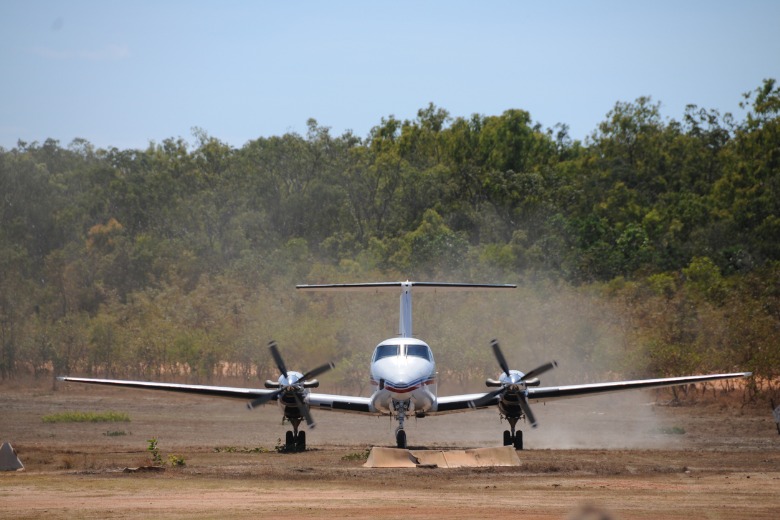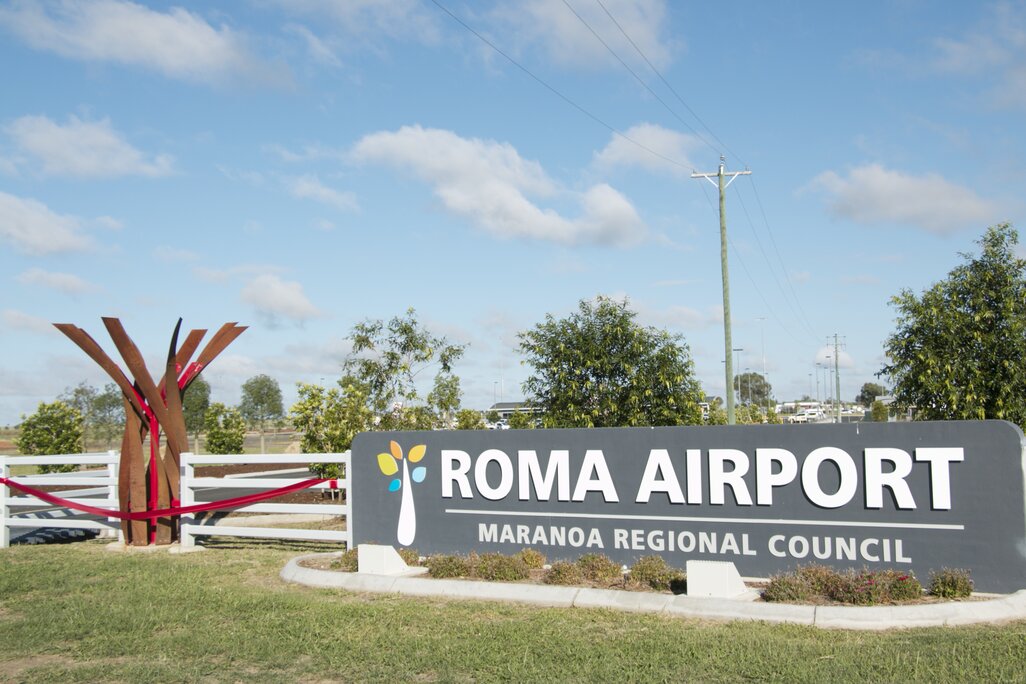
Many council owned airports are in a fight for survival and are calling for a government bailout to help them remain viable, ahead of a senate inquiry into the future of the aviation industry in a post COVID Australia.
More than 200 council airports across Australia provide essential services for the local community including passenger transport, tourism, postal services, air ambulances, emergency services, crop dusting, surveying and flight training.
But peak council and aviation bodies say COVID has put huge pressure on these operations and the exclusion of local government from JobKeeper has disproportionately affected council operated airports, putting at risk their ability to provide aviation services and straining already stretched council budgets.
Forced to tap into reserves
Ben Stewart is airports manager at Maranoa Council, which operates aerodrome facitlities at Roma, Injune, Surat and Mitchell.

Roma Airport is one of the busiest in regional Victoria, operating regular public transport flights to and from Brisbane, as well as servicing FIFO oil and gas sector workers.
The airport also houses a flying doctors base, an aeromedical service and an aero club and flying school.
Historically Roma 80,000 passengers a year.
Mr Stewart says Roma has faired better than a lot of other airports around the country.
Still, at the peak of shutdowns last April it lost about three quarters of its passengers and flights.
“We’ve been recovering and are now sitting around 50 per cent,” he says.
He admits that’s still a big hit and says Council has had to tap into the airport’s financial reserves to keep operating.
“The airports are operated on a user pays system so no rates money has gone to the airports for quite a few years,” he told Government News.
“Over the years we’ve put a bit of money away every years in case we need to do major work or if something unforseen happens, so we’re tapping into that this year for any shortfalls.”
‘Severe strain’
Bega Valley Shire Councilowns and operates Merimbula Airport which before COVID had 35 flights per week.
In a submission to a federal government issues paper released last August, General Mananger Leanne Barnes says the impact of COVID has been dramatic and put “severe strain on the ongoing viability of Merimbula airport”.
Passenger numbers have dropped around 95 per cent and income generated over the last nine months has been “almost negligible”, she says.
In a separate submission, Mt Isa City Council says it had to reduce the number of flights between Mount Isa and Brisbane in the early stages of the pandemic.
“Scheduling has slowly returned to pre-pandemic levels recently, although there now appears to be issues with the reliability of services, with cancelations not being uncommon,” the submission says.

Maranoa’s Ben Stewart says despite the difficulties he’s confident Maranoa’s airports will remain viable thanks to state and federal assistance and Council allowing airport tenants to reduce rent.
“I think the three levels of government are focusing on a brighter future,” he says.
“But certainly there’s some more opportunities from all levels of government that we can tap into some more funding.”
Rock bottom
According to the Australian Airports Association (AAA), of which more than 120 councils are members, passenger numbers at regional airports have decreased by more than 70 per cent since COVID; more than 70 per cent of regional airport staff have been made redundant, forced to take leave or been redeployed; and regional airports, which cost more than $334,000 a month to operate, are bleeding almost $7 million a month.
AAA Chief Executive James Goodwin says the majority of regional airports are owned and operated by local councils and provide a critical service to people living in rural, remote and regional Australia.
Regional airports were hit first, hit hard and will most certainly be one of the last to recover from the pandemic.
AAA CEO James Goodwin
“Regional airports were hit first, hit hard and will most certainly be one of the last to recover from the pandemic,” he told Government News.
Some council-owned and operated airports are almost hitting rock bottom and to make it even worse, they don’t have access to JobKeeper, he says.
Mr Goodwin says the number of flights servicing council-owned airports has reduced significantly and the few flights still operating are being subsided through the Federal Government’s Regional Aviation Network Support (RANS) program which is due to expire on March 28.

“Once it does, many regional routes will be in danger of becoming commercially unviable,” he says.
“If councils can’t afford to keep the lights on at the local airport, they will face additional challenges in supporting critical services such as medical flights, fire-fighting aircraft during the current bushfire season, freight planes and agricultural aircraft.”
The AAA is calling on the government to extend all aviation COVID-19 support measures for another six months.
The national local government peak body ALGA says financial stress during COVID has put the operation of some council-owned aiports at risk, 70 per cent of which were already operating at a loss before the pandemic.
The cost to many regional councils of providing an essential transport service during the pandemic has been significant.
Australian Local Government Association
ALGA is supporting the AAA’s call, made in a submission to the Senate inquiry, for an injection of federal funding into council-owned airports and aerodromes to ensure their ongoing viability in the same way it’s come to the aid of commercial airlines.
It also wants support for aviation related businesses operating in an out of regional airports.
“For local government, efficient infrastructure including airports is vital to ensure the sustainability of our regional and rural communities,” it says in its submission.
“ALGA agrees that the cost to many regional councils of providing an essential transport service during the pandemic has been significant”, it adds, including the costs of keeping lights on and runways open and providing security and other government mandated services.
LGNSW says in its submission to the issues paper that while the federal and state governments have helped with the capital costs of owning and operating aerodromes via grants programs over the years, “the recent COVID-19 pandemic has put the viability of many of these aerodromes under severe pressure”.
“This in turn has put tremendous strain on council budgets which have had to maintain operations by drawing on council funds that would otherwise be directed to other infrastructure and services to assist communities recovering from drought, the worst bushfires seen in a generation and more recently, the COVID-19 pandemic.
“The immediate injection of emergency funding to support the ongoing operation of the regular passenger transport routes network is vital.”
LGNSW says neither the Regional Airports Program announced by the Australian Government in the 2019-2020 budget (worth $100m over four years) or the Regional Airlines Funding Assistance Program (worth $100m) address the loss of vital operational income experienced by NSW councils resulting from reduced landing and passenger fees.
When combined with the loss of council revenue in other areas … it has a cumulative negative impact on council budgets and their ongoing ability to service their communities effectively.
Local Government NSW
“When combined with the loss of council revenue in other areas including council rates and other charges forgone as a result of COVID-19 impacts, it has a cumulative negative impact on council budgets and their ongoing ability to service their communities effectively.”
It also notes that a lot of aviation-related businesses have been badly impacted by the COVID-19 crisis in rural and regional areas, including local catering services, fuelling services, technical airline work crews, maintenance crews and works, airport kiosks, car hire and taxi service and even advertising agencies that use billboards at local airports.
Time for more flexibility
In the 1950s, ownership of many Australian government-owned airports was transferred to local governments and between 1989 and 1993 they were given full management and financial responsibility for them.
Under the transfer deeds, councils are obliged to continue owning and operating these aerodrome facilities unless they receive federal government permission to close or privatise.
But the government issues paper says that post-COVID, things might need to change.
“It may be timely to consider options for change to the oversight of (council) aerodromes to give local governments greater flexibility in determining the best long-term aviation solutions for their region,” it says.
The Senate’s Transport Committee will hold a public hearing on January 29, and is due to report by March 31.
Comment below to have your say on this story.
If you have a news story or tip-off, get in touch at editorial@governmentnews.com.au.
Sign up to the Government News newsletter
Australia is the 6th largest country in the world 7.692 Million Km2
We have a vast country and the small number of airports that we have each one is strategically important.
Given Post WWII the Federal government handed them over to Local government with the provisions that we read in this article.
We would be foolish to ignore the true value to our National security, being a Island Continent situated far away from our traditional strategic partners.
Perhaps the miss alignment between our strategic logistics and transport needs in the event of crisis and the minimal spend to ensure the future of these facilities is lost. The growth of what we see now as regional airports during WWII was because we realised and since forgotten that we are a country that is Large and the distances are vast.
Our air defensive capabilities are geared to use large airfields with F35 is not able to land at any regional airfield. Most of the airport have 8 ton limits be it the apron or taxiways the actual landing weights are consequently relatively low.
From a strategic and Home Defense position we have little usable Airports . The Senate’s committee is long overdue. Perhaps a stimulus measure is to revamp these regional airports to at least 737 capable!
With a shared funding arrangement. Perhaps buy back those airports we sold overseas interests!
Our airport in the far north of Western Australia is largely patronised and subsidised by transient Government employees (75-80%) enjoying training and recreational stints. These FIFO employees have distorted the local air travel costs, often to such high levels that local residents can’t afford to travel by air.
Flexible rate relief is far more important to me than trying to prop up the States strategic airfield industries. It’s time to sharpen the pencil!
Our Council owned Airport in Central Queensland
recently devalued the asset from about $70 million to $16 million. But the problem was there long before C19 came along. When State government wouldn’t come to the party the Council “went it alone” borrowing $68 million at almost 7% which in the long term will amount to almost $120 million bye pay back time. Rate payers have been made the “scape goat”, and Council avoids the flack because they have employed a Board of Managers to run the asset.
Rate payers never go to have a say whether the asset should have been relocated and redeveloped by another interested party, rather than Council embarking on record debt and a “wing and a prayer” repayment scheme .
The pain will lasts until 30 June 2030, but the Council’s subsidiary Airport Corporation will still owe rate payers about $33 million.
C19 was no where in sight – when the Council approved these arrangements about 5 years earlier.